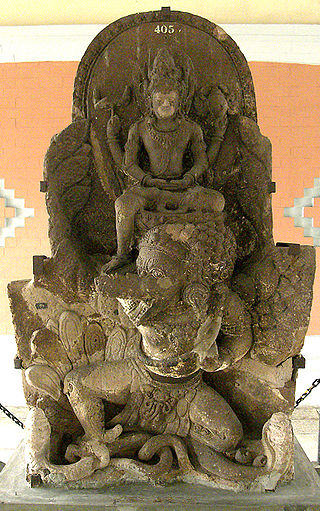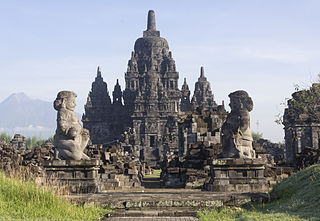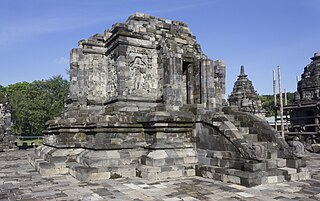
The Shailendra dynasty was the name of a notable Indianised dynasty that emerged in 8th-century Java, whose reign signified a cultural renaissance in the region. The Shailendras were active promoters of Mahayana Buddhism and covered the Kedu Plain of Central Java with Buddhist monuments, one of which is the colossal stupa of Borobudur, now a UNESCO World Heritage Site.

The Mataram kingdom ; also known as Medang kingdom was a Javanese Hindu-Buddhist kingdom that flourished between the 8th and 11th centuries. It was based in Central Java, and later in East Java. Established by King Sanjaya, the kingdom was ruled by the Shailendra dynasty and Ishana dynasty.

The Sanjaya dynasty was a Javanese dynasty which ruled the Mataram Kingdom in Java during the first millennium CE. The dynasty promoted Hinduism on the island.
Dharmawangsa, stylized regnal name Sri Maharaja Isyana Dharmawangsa Teguh Anantawikramottunggadewa of the Isyana dynasty, was the last Hindu raja of the Kingdom of Mataram, who reigned from 990 to 1016 CE. He is also known by his posthumous name Wijayamreta Wardhana, which means "powerful in glorious death", which refers to his fight to the death.

Airlangga, regnal name Rakai Halu Sri Lokeswara Dharmawangsa Airlangga Anantawikramottunggadewa, was the only king of the Kingdom of Kahuripan.

The Melayu Kingdom was a classical Buddhist kingdom located in what is now the Indonesian province of West Sumatra and Jambi.

Ratu Boko or Ratu Boko Palace is an archaeological site in Java. Ratu Boko is located on a plateau, about three kilometres south of Prambanan temple complex in Yogyakarta, Indonesia. The original name of this site is still unclear, however the local inhabitants named this site after King Boko, the legendary king mentioned in Roro Jonggrang folklore. In Javanese, Ratu Boko means "Stork King".
Balitung was a Javanese king of Mataram. Balitung was his birth name, though like other Javanese kings of this period, he was commonly referred to by his appanage title Rakai Watukura. He reigned from 10 May 898 to c. 911–912. His territories included a wide range of areas in Central Java and East Java.

Sewu is an eighth-century Mahayana Buddhist or Hindu located 800 metres north of Prambanan in Central Java, Indonesia. The word for a Hindu or Buddist temple in Indonesian is "candi", hence the common name is "Candi Sewu". Candi Sewu is the second largest Buddhist temple complex in Indonesia; Borobudur is the largest. Sewu predates near the "Loro Jonggrang" temple at Prambanan. Although the complex consists of 249 temples, this Javanese name translates to 'a thousand temples,' which originated from popular local folklore. Archaeologists believe the original name for the temple compound to be Manjusrigrha.

Pramodhawardhani was the queen consort of King Rakai Pikatan of Mataram Kingdom in 9th century Central Java. She was the daughter of Sailendran king Samaratungga.

The Padang Roco Inscription, in Indonesian Prasasti Padang Roco, is an inscription dated 1286 CE, discovered near the source of Batanghari river, Padangroco temple complex, Nagari Siguntur, Sitiung, Dharmasraya Regency, West Sumatra, Indonesia.
Karangtengah inscription is the inscription written on five pieces of stones dated 746 Saka or 824 CE, discovered in Karangtengah hamlet, Temanggung Regency, Central Java, Indonesia. The inscription was written in ancient Javanese script in two languages; Old Javanese and Sanskrit. Lines 1-24 were written in Sanskrit, and the rest of the lines were written in old Javanese. The inscription is linked with the temples Borobudur and Mendut.
The Tri Tepusan inscription is an inscription discovered in Kedu Plain, Temanggung Regency, Central Java, Indonesia, dated from 842 CE. This inscription is linked with the Borobudur Buddhist monument.

The Shivagrha inscription is an inscription from the Mataram Kingdom of Central Java, dated in chandrasengkala (chronogram) ”Wwalung Gunung sang wiku”, that is, the year 856 CE. The inscription was inscribed by order of Dyah Lokapala right after the end of Rakai Pikatan's reign and gave a detailed description of a grand temple compound dedicated to Shiva called Shivagrha, corresponding to the Prambanan temple compound.

The Manjusrigrha inscription is an inscription dated 714 Saka, written in Old Malay with Old Javanese script. The inscription was discovered in 1960 on the right side of the stairs entrance of Sewu pervara no. 202 on the west side. This inscription is linked to the Sewu temple. According to this inscription, the original name of the Sewu temple compound is probably Manjusrigrha. Sewu temple is located approximately 800 meters north of Prambanan temple, Central Java, Indonesia. The inscription was carved on an andesite stone block measured 71 cm x 42 cm x 29 cm.
Medang Kamulan was a semi-mythological kingdom that is believed to be once established somewhere in Central Java according to Javanese mythology. It is either perceived as the predecessor or the actual historical kingdom of the Medang Kingdom. "Kamulan" is derived from the word "mula" in Javanese and means "origin", hence "Medang Kamulan" can be interpreted as "pre-Medang" or "Medang the origin".

Lumbung or Candi Lumbung is a 9th-century Buddhist temple compound located within the complex of Prambanan Temple Tourism Park, Central Java, Indonesia. The original name of this temple is unknown, however the local Javanese named the temple "candi lumbung", which means "rice barn temple" in Javanese language.

The Kingdomship of Bali was a series of Hindu-Buddhist kingdoms that once ruled some parts of the volcanic island of Bali, in Lesser Sunda Islands, Indonesia. With a history of native Balinese kingship spanning from the early 10th to early 20th centuries, Balinese kingdoms demonstrated sophisticated Balinese court culture where native elements of spirit and ancestral reverence combined with Hindu influences—adopted from India through ancient Java intermediary—flourished, enriched and shaped Balinese culture.
Isyana stylized as Sri Isyana Tunggawijaya was a queen regnant of Mataram Kingdom, in East Java, that ruled since 947 CE. She co-reigned with her spouse, Sri Lokapala. The Isyana dynasty, established by her father, Mpu Sindok that ruled Java circa the 10th century CE, was named after her.

Mataram–Srivijayan wars, also called as Pralaya in Javanese inscription of Pucangan, were a military engagements between two rival kingdoms of the Srivijaya of Shailendra and Mataram kingdom of Ishana, intermittently from c. 937 when the Srivijayan forces attempted to approach the Mataram capital, until 1016 when the kingdom of Mataram was collapsed due to a rebellion incited by Srivijaya.















